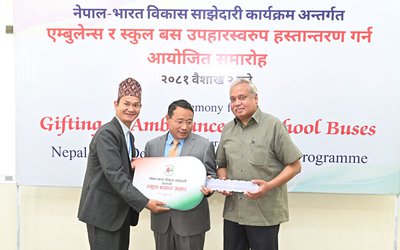With the COP 22 just a few weeks away, Nepalese Army averted a major Glacial Lake Outflank (GLOF) in the Everest region. The Imja Glacier was in a vulnerable situation, brimming with the possibility of heavy damage in the lower area.
With months of efforts, Nepal Army soldiers and local villagers dug through rocks and boulders to drain a glacial lake just south of Mount Everest, bringing the water to a safe level and possibly preventing an outburst that could have flooded several villages.
“We were able to lower the Imjalake’s water level,” said Lt. Col. Bharat Lal Shrestha, who led the team of soldiers. “We were able to lower Imja Lake’s level of water by 3.4 metres (11 feet), making it safe and for now averting the risk of outburst.”
The Army has successfully drained out water from Imja Lake in Solukhumbu to safe levels, reducing the water level by 3.5 metres within five months in bid to save the downstream villages from glacial lake outburst floods.
According to experts, Imja Lake is one of the fastest growing glacial lakes in the Himalayan region. According to the Department of Hydrology and Meteorology, the targeted water level to mitigate the risk of GLOFs has been drained.
“We succeeded in reducing the water level to a safe point, and are preparing to organise a formal programme to hand over the project to the Nepali Army,” Rishi Ram Sharma, director general at the department, told The Himalayan Times. He said the Nepali Army will be handed the project by November this year.
A team from the Department of Hydrology and Meteorology had started the project from September 24 by releasing water through the lake’s main gate. Before starting the draining process, the department had alerted locals of villages located downstream from the lake to the dangers of the rising water levels in Imja Lake and the Dudhkoshi River.
The project was initiated by the Department of Hydrology and Meteorology under the $ 7.2 million budgeted Community Based Flood and Glacial Lake Outburst Risk Reduction Project. The project aims to reduce possible loss of human lives and infrastructure from GLOFs in Solukhumbu and the downstream areas of Mahottari, Siraha, Saptari, and Udaypur.
The Nepali Army constructed the outlet gate to release water accumulated since June 1 this year. NA personnel had constructed a three-metre wide and 1.5-metre deep outlet channel to drain the water. As many as 40 personnel and 62 civilians were involved in the task.
The lake is 180 metres deep, two kilometres long, 650 metres wide, and is spread over 130 hectares. The surface area of the lake is said to have expanded from 0.4 to 1.01 square kilometres between 1984 and 2009 due to the rapid melting of snow. An estimated 96,562 people are living in vulnerable areas downstream of the Imjalake. The programme to drain the lake water was funded by United Nations Development Programme and the Global Environment Facility.
Nepal is ranked as the fourth most vulnerable country in the world due to the impacts of climate change. A total of 3,808 glaciers and 1466 glacial lakes have been identified in Nepal. These lakes include 21 potentially dangerous lakes, out of which six are at very high risk. TshoRolpa and Imja Lakes are among them. Around 21 glacial lakes pose high risk of glacial lake outburst floods due to climate change.
The 40 soldiers working with 100 villagers dug through boulders and rocks to build an outlet to drain out as much as 1 million cubic litres of water.
The lake, at 5,000 metres (16,400 feet) altitude, is considered one of the most likely glacial lakes to have an outburst.
The Nepalese Army has successfully completed the operation to drain the risky glacial lake near Mount Everest.
Although the risk of flooding from this glacial lake has been reduced, climate experts warn that the overall threat is far from over. Many similar lakes pose a danger to adjacent villages as well as Indian population centers further downstream.
The surging waters from this glacier would have uprooted more than 50,000 people living in the nearby villages as well as the southern district of the country. “Due to the climatic changes, Himalayan glaciers are melting at an alarming rate which has created numerous glacial lakes and some of these lakes are so huge and dangerous that they are environmental risks. In fact, these dangerous lakes are not only a concern for Nepal but are likely to impact vast areas in India if they break out.
- TANAHU HYDROPOWER PROEJCT: A Significant Achievement
- Apr 15, 2024
- AMBASSADOR HANAN GODAR: Sharing Pain With A Nepali Family
- Mar 30, 2024
- VISIT OF KfW AND EIB TO NEPAL : Mission Matters
- Mar 25, 2024
- NEPAL BRITAIN SOCIETY: Pratima Pande's Leadership
- Mar 24, 2024
- NEPAL ARMY DAY: Time To Recall Glory
- Mar 15, 2024
















